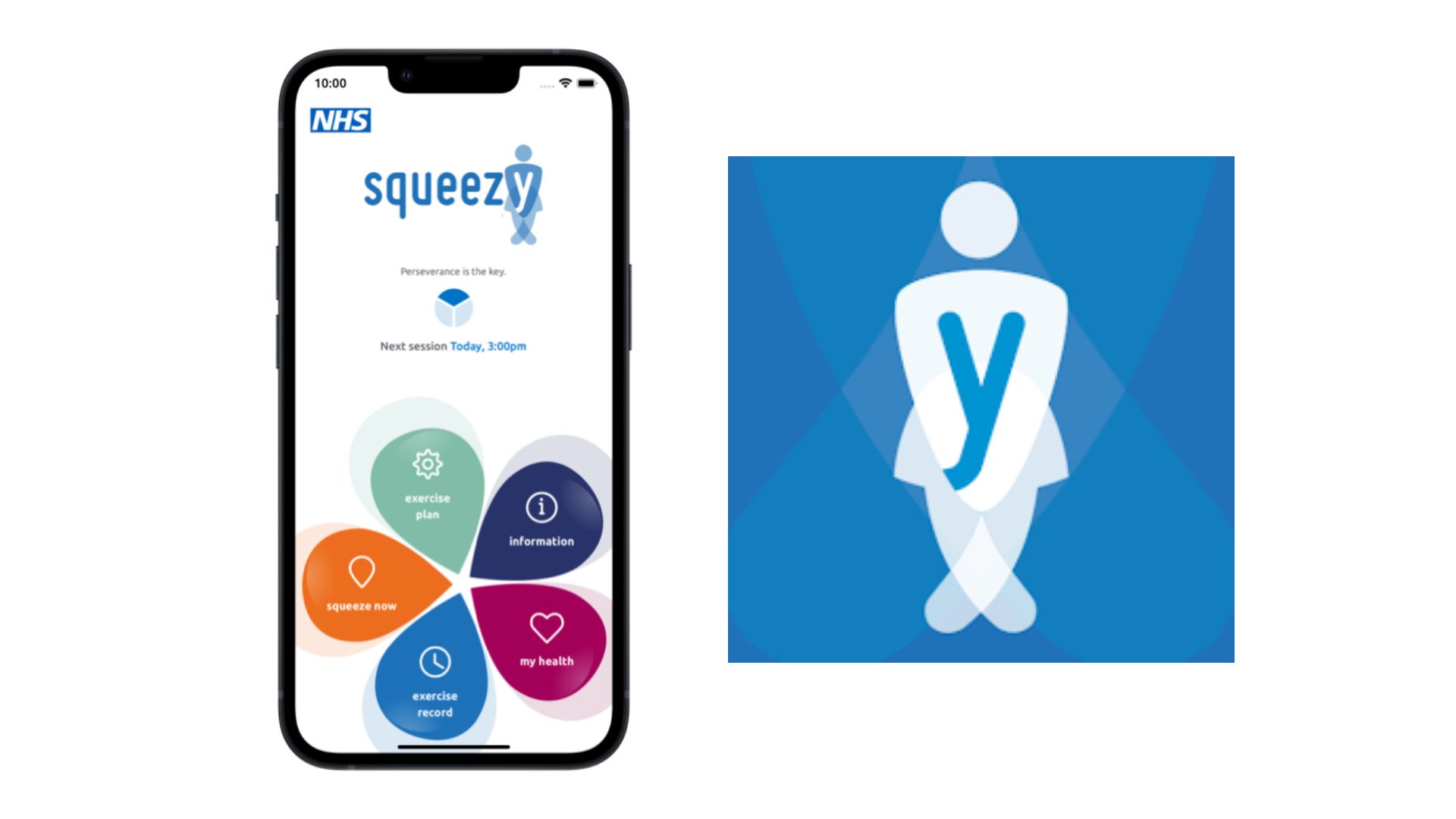The 11 best pelvic floor trainers in 2025
The best pelvic floor trainers come in all forms, from apps to high-tech wearables. Here we review the top-rated devices and reveal whether they are worth it


Mandy Ruther
One of the best pelvic floor trainers can help you maintain the group of muscles that run around the bladder, vaginal walls, and anus that's known as the pelvic floor.
Pelvic floor muscles are some of the most undervalued in the body. They physically support the bladder and the ureters (tubes that carry urine from the kidney to the bladder, rectum, and reproductive organs) and reduce the risk of incontinence by letting us close the anal, vagina, and urethral canals. So, it's no surprise that keeping the pelvic floor healthy should be a top priority - especially as the muscles naturally weaken with age and following life events like childbirth and menopause.
In 2025, we're going to see even more focus on pelvic floor health and the importance of integrating kegel exercises (contractions of the pelvic floor designed to strengthen the muscles) into daily life. That's where pelvic floor trainers come in - but there are big differences in function, style, and price point between them. So, we asked the experts for specific recommendations and tested them with a team of expert reviewers.
Top 3 picks

Best overall
This wearable device sends alerts to your phone to let you know how to keep your Kegel practice in check. It's an effective, comfortable choice that also allows you to closely monitor your progress and our tester thinks it's unbeatable for efficacy.

Best app-free
If you already know the Kegel exercises you need to see results, then this more affordable, no-complication trainer is excellent. Straightforward to insert, use and see results from, this is a no-nonsense option if you don't need the extra help of the Elvie.

Best app
You can get access to this NHS-made app for almost nothing (£2.99) and get access to programs to help you train your pelvic floor just by having your phone to hand. For beginners or those looking for something to supplement the device they already own, it's a no-brainer. Available on the App Store and Google Play.
The best pelvic floor trainers, tried and tested by us

Best pelvic floor trainer overall
Specifications
Reasons to buy
Reasons to avoid
The Elvie pelvic floor trainer is our top pick for many reasons but the primary one is that it's so practical and easy to use. It feels comfortable to wear and the app is simple with progress bars in-app to record your kegel exercises. Plus, you only have to do the exercises three times a week to reap the benefits for the pelvic floor.
"It’s nice to look at, it's waterproof, and it didn’t slip down thanks to the shape," says Mandy Ruther, our tester for this device."It's also the only device out of all those tested that I'd recommend to friends and pick up over and over again to improve my pelvic floor health. While the others have their benefits, this one fit the most seamlessly into my daily routine."
Some pelvic floor trainers can feel like medical devices, but this one feels like a wellness tool, she says. It's less invasive and you only have to do the exercises a few times a week. "I know I’m more likely to use the Elvie because I liked it more. It’s straightforward, not fiddly, so it's worth the price tag in my eyes," she says.
"The only thing I disliked about the design is that there’s no external button. A firm squeeze on the device body wakes it and ensures it pairs with the app… but occasionally the app loses connection mid-exercise and you take it out and squeeze again. A button on the end of the “spoon handle” would have been more convenient," she says.
Read our full review on the Elvie pelvic floor trainer here.

Best premium pelvic floor device
Specifications
Reasons to buy
Reasons to avoid
The Femfit by Junofem has eight sensors, making it one of the most detailed pelvic floor trainers, offering the most advanced insights. Our resident pelvic floor trainer tester Mandy Ruther reviewed the device for several weeks and found it to be a must-have for three reasons: detailed feedback, personalised programs, and real-world application, in that you can share your results of using this trainer with a medical expert to assess any ongoing issues.
It pairs with an app via Bluetooth to give you immediate feedback while you're performing the exercises, which you need to do daily.
"The initial three-day programme to learn the exercises gets you doing them all but is so quick that I found myself doing it two or three times. Not so when you get on to the real deal: the Strength Builder programme. This takes around 10 minutes a day for 12 weeks. You start doing the exercises lying down then sitting, and ultimately standing. Intensity and repetitions increase over time - but I hardly noticed," says Mandy Ruther.
While pricier than any other pelvic floor trainer on the list, it's clinically proven to lessen up to 80% of urinary incontinence symptoms in 12 weeks with the Strength Builder programme, per the brand's own research.
Read our full review of the Junofem Femfit pelvic floor trainer here.
Best app-free pelvic floor trainer

Specifications
Reasons to buy
Reasons to avoid
As reviewed by Mandy Ruther, the Intimina KegelSmart2 is the best model of pelvic floor trainer for those who already know how to do kegel exercises. As an app-free trainer, the KegelSmart 2 uses touch sensors to register your pelvic floor strength and then automatically adjusts the program level as your strength improves.
Ruther says the device is comfortable to insert and easy to use, with a five-minute pre-scheduled routine of vibration patterns. This routine is much shorter than many of the other devices reviewed, so it's perfect if you're short on time.
The idea is that you clench your pelvic floor muscles when you feel the vibrations and relax them when they stop. It works best when you're lying down and relaxing, she says, with your attention on the program as the vibrations are pretty gentle so you'll need to concentrate to follow the routine correctly. As you get stronger, the device will automatically adjust its intensity, so it motivates you to improve with the same device over time.
One difference between the Intimina KegelSmart 2 and the first model is the power system. The original model was battery-powered, meaning you always had to have a spare set on hand for when yours inevitably ran out, whereas the newer version is rechargeable. At under £100, it's also one of the most affordable options on this list. However, if you don't mind a battery-powered device and you're looking to spend even less, you could always opt for the older model.
Our Intimina KegelSmart 2 review has the full details.

Best pelvic floor internal wearable device
4. Perifit
Our expert review:
Specifications
Reasons to buy
Reasons to avoid
Perifit is a kegel exerciser that allows you to control and play video games with your pelvic floor via your smartphone. A French femtech company created this wearable silicone device using unique, patented double pressure-sensor technology to identify faulty contractions. The insertable part is 26mm wide, designed to comfortably fit all body types and accurately measure pelvic floor lift strength.
Perifit uses proprietary algorithms to assess your pelvic floor performance against five key metrics: strength, endurance, frequency, release, and accuracy. After just a couple of days of using this device, I noticed a real change in these scores. The metrics allow the virtual coach to train you using a set of custom-designed Kegel exercises for faster improvement.
When testing out the device, I found it easy to use. To activate it, you scan a QR code on your mobile phone and follow the step-by-step setup process, which includes a survey to determine your needs and deal with issues like incontinence. Once you're in, and before the games begin, there's a fantastic training mode which I found helpful for practicing my technique. Then, you're free to explore all the games on offer. While they might sound trivial, it's all in the name of a better pelvic floor and I found them fun by the end - catching birds and avoiding obstacles by using the muscles around my pelvic floor.
Inserting the device is also very easy as it's made from medical-grade silicone, not unlike many of my favourite sex toys - but this one doesn't buzz at all. It's small and has an attached loop, a bit like a tampon string, to help you pull it out after use. The Perifit trainer isn’t suitable for those who are pregnant or people with chronic pelvic pain though, so be sure to consult your doctor if you have any concerns about this.

The best pelvic floor trainer app
5. Squeezy App
Our expert review:
Specifications
Reasons to buy
Reasons to avoid
Looking for one of the best pelvic floor trainers under £5? The NHS has created an app called Squeezy which, as affordable pelvic trainers go, is good. Squeezy is a multi-award-winning app supporting pelvic floor muscle exercise programs. Designed by chartered physiotherapists specializing in women’s and men’s pelvic health, Squeezy offers a range of games and exercises to do while looking at your phone or device.
When testing the app for myself, I appreciated how it came with a pre-set exercise plan recommended by a pelvic health physiotherapist that follows National Institute for Health and Care Excellence (NICE) guidelines - so I knew it would definitely be working. I found the app then sends reminders to follow the plan daily, which was good, otherwise, I may have forgotten to use it. The service is also super simple to use, I thought, as it's just an app. However, you must know how to do Kegel exercises already to use this device effectively.
Squeezy’s pre-set exercise plan can be tailored to fit your needs as well. There’s also a journal area to track any symptoms and improvements, which I thought was beneficial.
Much like the Intimina KegelSmart 2, there's no way to tell whether you're doing the pelvic floor exercises correctly so this is an option for those more advanced at kegels. However, if you’re comfortable with measuring your progress and doing your kegel exercises effectively and dislike the idea of a wearable or inserting a manual device, this stand-alone app is a great guide to keep you on track and provides helpful resources too.

Best weighted pelvic floor trainer
6. Kegel8 Exercise Weights
Our expert review:
Specifications
Reasons to buy
Reasons to avoid
Kegel8 creates a variety of pelvic training devices, some with biofeedback sensors and some with electric pulse toning technology, but it’s the exercise weights I'm raving about.
These Kegel balls come in three progressive sizes and gradual weight increments, but I'd suggest using the lightest one to begin with and making use of the unique indicator clip, so you can see that you're doing the exercises correctly. This is the tail you'll see on the end of the Kegel balls and when it moves down, you're doing the exercise perfectly. If the tail moves up, you are pushing through what's called a 'bad kegel' because it's not exercising or strengthening the muscles at all so it is important to know how to use Kegel balls before trying these.
As you progress through Kegel8’s 12-week plan, you have to gradually increase the weight as your pelvic muscle strength improves, which is what I liked about this pick of the best pelvic floor trainers. Instead of working your way through exercises that stay relatively the same throughout the program, this one helps you actively test the strength of your pelvic muscles.
There's even research to back up the use of these Kegel balls or cones, as they're otherwise called. Research from the University of Otago reveals that weighted vaginal exercise balls have a 70% success rate with stress incontinence in clinical trials when they're used for 12 weeks.

Best manual pelvic floor trainer
7. Intimate Rose Pelvic Wand
Our expert review:
Specifications
Reasons to buy
Reasons to avoid
Not all pelvic trainers are for strengthening your muscles, some are intended to help release tension. If your muscles are tight, causing discomfort or you’re suffering from a hypertonic pelvic floor or dyspareunia (pain during sex), vaginal massage can release tension. Enter the Intimate Rose Pelvic Wand - designed to help relieve trigger points including the hard-to-reach obturator internusand puborectalis muscles, a section of muscle that helps maintain the pelvic floor.
I found the Intimate Rose Pelvic Wand easy to use. It's made from medical-grade silicone, which makes insertion easy with just a slick of your best lube, and has a unique shape with different-sized ends so I was always sure which side to use. Once the wand is inserted, I could practice Kegels to get a feel for which muscles were tight. Seeing the wand move will also show you whether you’re performing the exercise correctly. With no tech, batteries or charging aren't required.
Pelvic trainers in the form of wands will work for some people, however, they do take a little time to get used to and can be difficult to use at first - much like the best wand vibrators. Follow the Intimate Rose instruction manual included with the product to help you master your Kegels using a wand.

Best pelvic floor trainer starter kit
8. Secret Whispers Kegel Balls
Our expert review:
Specifications
Reasons to buy
Reasons to avoid
Secret Whispers Kegel balls were created by a passionate UK entrepreneur, Julie Colan. Julie's multi-award-winning Six-Step Pelvic Floor Exercise Kit aims to get women leak-free in as little as 15 minutes daily and "back to enjoying the life they deserve".
These silicone weights are smaller than others on our list at just 1.06 inches. I found they fit comfortably in the palm of my hand but I'd still recommend using a splash of lube or water to help insert them if you're new to these types of toys. The idea is to work your way up from the lightest weight at 15g to the heaviest at 55g, all at your own pace, rather than following a set program. But don't worry, you won't be left to figure things out. The Secret Whispers brand boasts a huge online community of women who are always keen to discuss the benefits of the weights, how to use them, and the issues that can be treated by using them.
The starter kit is affordable - another huge bonus compared to some of the other pelvic floor trainers on our list, and they can be used long-term. The instructions suggest wearing your weights three to four times a week to maintain the strength of your pelvic floor.
I also loved how this kit came with a discrete travel bag, a 90-day Pelvic Floor Challenge Accountability Diary, your Exercise Program, and a PDF ebook to help you out with some of the more frequently asked questions.

Best pelvic floor trainer for affordable quality
9. LoveHoney Health Kegel Training Set
Our expert review:
Specifications
Reasons to buy
Reasons to avoid
I'm a huge fan of the other products from Lovehoney - especially when they are in the Lovehoney sale - so I was excited to try these kegel balls as part of the best pelvic floor trainers selection. Lovehoney Health is a range of body-safe sexual health accessories created by the famed sexual health brand to empower you to take control of your intimate health. LoveHoney Health's newly designed Kegel Training Set is crafted from soft silicone and shaped for easy, progressive training. They were easy to insert thanks to the soft silicone feel and manageable size, and the set uses three progressively weighted kegel exercisers to tone and strengthen your pelvic floor.
The set includes one Kegel exerciser, weighing 50g, and two double Kegel exercisers, weighing 80g and 100g. Each has a removal loop that remains outside the body for straightforward retrieval when you're ready to take them out.
Unlike the Secret Whispers wearables, these Kegel balls range in shape, size, and weight. While you might be able to get away with a splash of water for the other ones, it's best to use these Lovehoney Kegel balls with a liberal amount of lube as they are easy to insert but it doesn't hurt to have a little extra help when you're moving up a weight class. This set is also great for long-term use and with a decent price point, I believe it's a great entry set without all the bells and whistles.

Best pelvic floor trainer for incremental pelvic training
10. Tracey Cox Supersex Kegel Training Kit
Our expert review:
Specifications
Reasons to buy
Reasons to avoid
Another excellent buy from Lovehoney, this set of six weighted kegel balls features six impressive weight classes to choose from. Developed by expert Tracey Cox, the idea is to gradually move up to a heavier kegel ball to help with your muscle strength. You should be able to squeeze comfortably around the ball and then release it.
Don't worry if you can't hold the heavier ball inside yourself to begin with. This just means that your pelvic floor muscles aren't strong enough right now, so go at a pace that suits you, and don't rush to move to a heavier pick too quickly.
These balls are very easy to insert as they're also made from medical-grade silicone and the long tail hangs outside the body for easy removal, a feature I appreciate with these trainers. I also liked the color-coded system these kegel weights come in as it makes it super simple to determine which weight you're using. The total of six weights means incremental training is easier than with other trainers too, so if you're looking to complete this type of exercise, doing it with this device will be better - no matter the strength of your pelvic floor.
"It's advice I give all the time. If you want to have great sex and longer-lasting pelvic health, keep your genital fit and toned," says Tracey Cox, an international sex, relationship, and body confidence expert, and creator of the set. Her philosophy, that great sex takes work and self-focus, is built within this set as it aims to help anyone with a range of pelvic floor issues.

Best tech-free pelvic floor trainer
11. Femvaults Pelvic Floor Trainer
Our expert review:
Specifications
Reasons to buy
Reasons to avoid
Femvaults is a noninvasive and manual device for those who want extra help doing Kegels. Unlike most other devices on this list, the Femvaults is not worn internally. It's larger than the picture makes it seem and it's worn between the legs, creating resistance between the thigh and glute muscles. When you squeeze these muscles, which you use regularly anyway, you'll naturally squeeze your pelvic floor muscles.
I preferred using this device while standing and experienced the best training in this position, but you can also use the Femvaults while seated, lying down, on all fours, or kneeling. It does feel quite bulky compared to the other trainers on the list but its size and mechanism make it so effective. Plus, I found it only took a couple of tries to get it right and once I had the hang of it, it became much easier.
It's more affordable than other tech-based pelvic trainers in this guide as well. However, being a manual device, the Femvaults doesn’t offer biofeedback, tracking, reminders, or readings. So, if those insights are more valuable to you than the affordability of a device, this might not be the one for you. However, it does offer support in strengthening the entire hammock of muscles that wrap around the pelvic region as well as the glutes and upper thighs in a more holistic manner, rather than zoning in on the vaginal muscle walls. I think it's also a good entry point to pelvic floor exercises for those who are totally new to the practice.
Testing the best pelvic floor trainers
How we tested
We've tested these devices over the last three years. In 2025, we can confirm these are still considered to be the best devices for quality, value for money, and ease of use.
I spoke to experts such as Dr Shirin Lakhani, an aesthetic physician and intimate health expert, to determine what makes the best pelvic floor trainer and how to use a pelvic floor trainer in the best way. We also asked for her recommendations on the best ones to use - ranging from products suitable for those totally new to the devices to those who've used them many times before.
"Your pelvic floor is essential for controlling your bladder and bowel movements and it can get weaker over time, as a result of childbirth and also as we age," she says. "Pelvic floor trainers can be really useful to target the pelvic floor muscles and the muscles at the neck of the bladder. Many people use them to improve control over bladder and bowel functions and for recovery after childbirth. They can also help reduce the risk of prolapse and improve sex lives, which is why you'll often see kegel balls in round-ups of the best sex toys as well.”
As well as seeking expert advice on what makes a good pelvic floor trainer, I tested them myself and called in fellow testers where needed. Through the testing process, we considered the following criteria:
- Comfort: Pelvic floor trainers need to be comfortable. Most programs recommend using the devices regularly for best results, so the trainers need to be easy to insert and manageable to hold during use. We only included devices in our range that I found comfortable to use.
- Functionality: While we can't speak to the long-term use of the device as I only tested these trainers for a couple of weeks, it was important that I could feel the trainer working on my pelvic floor muscles. I tested this either using the app that came with the device, as this often reveals whether you're doing it right, or by using my own knowledge of pelvic floor exercises and Kegel exercises.
- Ease of use: No one wants a struggle with their pelvic floor trainer. This goes for ease of use both with the trainer itself and any associated technology, so I noted whether the trainer was easy to use and gain results from, and whether the technology was simple to navigate for potential first-time users.
- Type of pelvic floor trainer: There are many types of pelvic floor trainers out there, so we tested a variety - from classic trainers to Bluetooth-enabled devices, mechanical kegel balls to manual ones. “Apps can monitor your progress and set different workouts and will most likely lead you through a series of exercises and workouts that are usually five to ten minutes long. Pelvic exercisers work best if you use them consistently over time. The app will usually remind you when it's time to do the exercises and it can help you stick to a routine," says Dr Lakhani.

Dr Shirin Lakhani MBBS MRCGP DRCOG is a GP, aesthetic physician, an award-winning cosmetic doctor, and the founder of Elite Aesthetics, with a significant voice of authority within the women's health space.
How to choose the best pelvic floor trainer for you
- Consider whether they're right for you to begin with: A common misconception about pelvic floor trainers is that everyone can use them. This isn't the case, Dr Lakhani says. "Anyone experiencing urinary incontinence, pelvic pain or pressure, hip pain, sexual difficulty, or fecal incontinence should have a professional examination first trying to use one of these devices."
- Choose between Kegel balls or a trainer: These are two of the most popular types of pelvic floor trainers and the top-rated ones on our list. However, they are very different. “Pelvic floor trainers are most often a small contraption often connected to an app on your phone. The device is inserted into the vagina and helps you to ensure you are doing the exercises correctly,” says Dr Lakhani. "Kegel balls, which are small, weighted balls, have been used for centuries and are inserted into the vagina."
- Bluetooth connectivity or not: Similarly, you may decide that using a pelvic floor trainer with smartphone connectivity features is a little too much for you. These devices do tend to be more complex than even non-manual, battery-operated devices.
- Short-term or long-term trainer: Some trainers can make a difference in just a couple of weeks whereas others require a longer-term commitment of a few months minimum. After speaking to your doctor and before buying, consider the variety of trainers out there and how long they've suggested you use the device.
Who can use a pelvic floor trainer?
You can start pelvic floor exercises at any age and any stage in your life, it's never too early or late. As with any muscle, the pelvic floor can become stronger and more effective the more you work it, says Dr Ruth Maher, who specialises in women's health and physiotherapy.
It's a common misconception that pelvic issues only affect older women - pelvic floor dysfunction is present across all ages. Pelvic pain, incontinence, painful sex, and painful masturbation can all occur in the late teens right through to when the symptoms of perimenopause begin and the postmenopausal period starts. Pelvic issues and pelvic pain are also common in former athletes, research from the Technological Education Institute in Athens reveals, as these muscles tend to come under particular strain over years of exercise.
While pelvic floor trainers are suitable for a host of conditions and are proven to be hugely beneficial in managing certain painful situations, Maher, who is also the co-inventor of INNOVO, also recommends them for some people experiencing issues as a result of certain life stages such as "urinary stress incontinence and for women who have just experienced childbirth," she says.
Ultimately, you should speak with your doctor before using a pelvic floor trainer. You may need physical therapy and certain devices may also worsen your condition.
Dr Ruth Maher is a medical doctor and the co-inventor of Innovo, a device for improving pelvic floor health. She specialised in pelvic floor dysfunction with her PhD, exploring alternative solutions to effectively facilitate pelvic floor contractions. Dr Maher has worked in the US and at University College Dublin (UCD).
What are the different types of pelvic floor trainer?
There are a few different styles of pelvic exerciser and you may need to try one or two before you can decide which is right for you. If you dislike the idea of inserting something, you can try starting with an app that instructs you on how to do manual kegels.
These are the main types of pelvic floor trainer to consider:
- Biofeedback wearables and devices - wearables are inserted into the vagina like a tampon and are used to ensure you're contracting your pelvic floor muscles correctly when doing exercises. Most wearables are connected to an app that can provide detailed feedback on your workout and monitor your progress.
- Apps and smartphone games - you can also use pelvic floor training apps without connecting them to a wearable. Apps can guide you through your Kegels and some even have even gamified the process to help you master your technique.
- Kegel weights and Kegel balls - similar to other wearables, Kegel weights and balls are inserted into the vagina and used to help you perform Kegels correctly. Usually, they aren't linked to an app so won't monitor your progress.
- Electrical muscle stimulation - delivering gentle muscles stimulations, pelvic trainers like the INNOVO Pelvic Floor Device stimulate the pelvic floor to strengthen muscles and improve bladder function.
With so many options available, it's important to speak with your doctor before undertaking any form of exercise or purchasing an at-home device. Dr Selena Langdon, who trained in both aesthetic medicine and general practice, says, "While most are safe for use, there are contraindications such as those with vaginal mesh implants, prolapse or vaginal atrophy. It is very important to be aware that there is no regulation of these machines, so it is very important to do as much research as possible."
Sign up to our free daily email for the latest royal and entertainment news, interesting opinion, expert advice on styling and beauty trends, and no-nonsense guides to the health and wellness questions you want answered.
Emilie Lavinia is a writer, entrepreneur and women’s wellbeing advocate. She is passionate about femtech, closing the gender health gap and campaigning for education and transparency across mental, physical and sexual health. Emilie presents All Being Well – a series that investigates the concept of wellness, good health according to experts and what it means to ‘be well’. She has a decade of experience as a journalist, editor and brand strategist and is the founder of four separate organisations that champion women’s health, marginalised communities and LGBTQ+ people.
